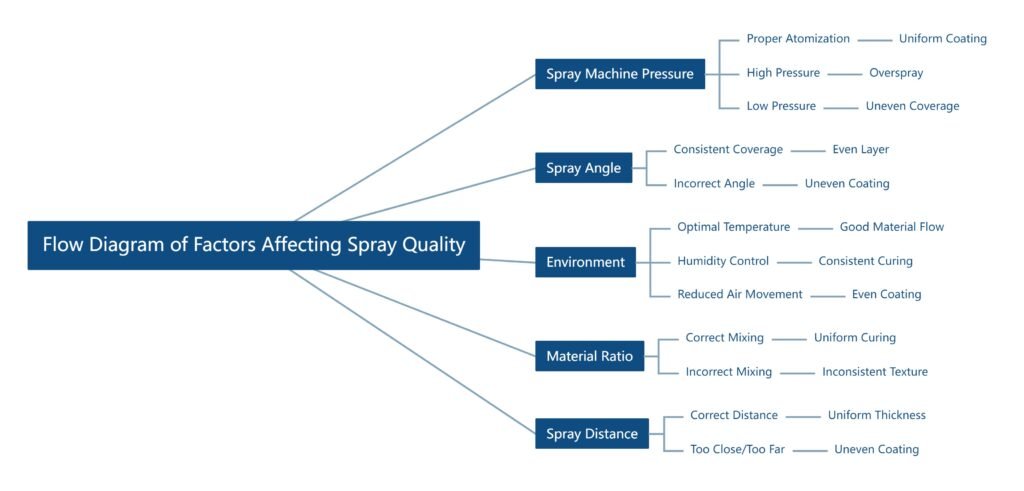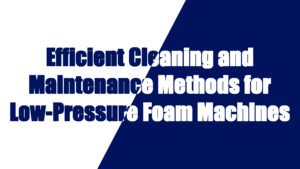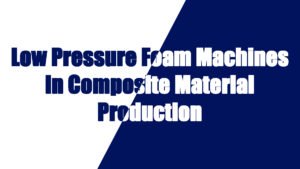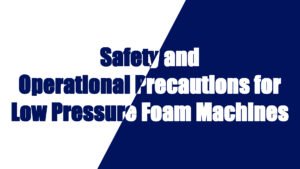Polyurethane spray applications are widely used in various industries, including Isolierung, Konstruktion, automotive, and Verpackung. The quality of the spray coating directly influences the final product’s performance, durability, and appearance. Several factors can impact the quality of the polyurethane spray, and understanding these factors is crucial for achieving optimal results.
In this article, we will discuss the key factors that affect polyurethane spray quality, such as spray machine pressure, spray angle, construction environment, and material mixing ratio. We will also provide visual aids like charts and flow diagrams to help users better understand how these factors interact and impact the final coating.
Spray Machine Pressure
The pressure at which the polyurethane material is sprayed plays a significant role in the spray quality. The correct pressure ensures that the material is atomized effectively, providing a uniform coating.
Pressure Too Low
- Result:Inadequate atomization of the polyurethane material, resulting in uneven coverage and large droplets.
- Solution:Increase the pressure to ensure consistent atomization and a finer, more uniform spray pattern.
Pressure Too High
- Result:Over-atomization can cause overspray, wastage of material, and an uneven coating with a rough texture.
- Solution:Adjust the pressure to maintain a smooth, even spray with minimal overspray.
Recommended Pressure Range: For most spray applications, the pressure typically ranges from 1500 psi to 2500 psi. However, this varies based on the type of machine and the material being sprayed.
Spray Angle
The angle at which the spray gun is held can impact the quality and consistency of the spray pattern.
Correct Spray Angle
- Result:A consistent, even layer of polyurethane is applied, ensuring proper adhesion and coverage on the substrate.
- Solution: The spray gun should be held at a 90-degree angle to the surface for uniform coverage. In some cases, a slight angle of 30-45 degrees can be used to improve reach and surface coverage.
Incorrect Spray Angle
- Result:Uneven spray application, leading to areas of excessive buildup or insufficient coverage.
- Solution:Maintain a steady, consistent spray angle, and avoid tilting the gun too much to prevent irregular coating.
Note: The ideal spray angle may vary depending on the type of material being sprayed and the surface being coated. For large surface areas, it may be necessary to adjust the angle to ensure better material distribution.
Konstruktion Environment
The environment in which the spraying takes place can affect the spray quality. Temperature, humidity, and air movement are all environmental factors that influence polyurethane spray applications.
Temperature
- Effect:Low temperatures can cause polyurethane to thicken, leading to poor flow and application. High temperatures can lead to premature curing and reduced working time.
- Solution:Ensure that the spraying is carried out within the recommended temperature range of 15-30°C (59-86°F) for optimal material flow and curing.
Humidity
- Effect:High humidity can affect the curing process, resulting in a slower cure time or inconsistent curing. Low humidity may cause the material to dry too quickly, leading to a rough surface.
- Solution: Maintain a humidity level between 40% and 60% for optimal curing conditions.
Air Movement
- Effect: Wind and drafts can lead to overspray and uneven application, causing material wastage and inconsistent coating thickness.
- Solution: Try to apply the coating in a controlled, sheltered environment, or use a spray booth to reduce air movement that could disturb the spray pattern.
Material Mischverhältnis
The material mixing ratio, particularly for two-component polyurethane systems (Part A and Part B), is a critical factor in achieving consistent spray quality.
Correct Mixing Ratio
- Result: Properly mixed materials ensure consistent chemical reaction, leading to uniform curing and performance of the spray.
- Solution: Always follow the manufacturer’s guidelines for the correct mixing ratio. Typically, the ratio for polyurethane is 1:1 or 2:1 (Part A to Part B), but it may vary depending on the specific product.
Incorrect Mischverhältnis
- Result: Improperly mixed materials can cause issues such as poor adhesion, incomplete curing, uneven texture, or delamination of the spray layer.
- Solution: Use a mixing system or metering pumps to ensure accurate proportions of Part A and Part B. Regularly check the mixture for consistency.
Spray Distance
The distance between the spray gun and the surface being coated can also impact the final quality.
Correct Spray Distance
- Result:A spray distance of approximately 8-12 inches (20-30 cm) ensures proper atomization and even coverage.
- Solution: Maintain a consistent distance throughout the spraying process to achieve uniform coating thickness.
Too Close
- Result: If the spray gun is too close to the surface, it may result in excess material buildup, leading to uneven application and surface defects.
- Solution:Keep the spray gun at the recommended distance to avoid heavy buildup in certain areas.
Too Far
- Result:If the spray gun is too far from the surface, it may result in poor atomization, large droplets, and uneven coverage.
- Solution: Adjust the spray distance based on the material’s viscosity and the desired spray pattern.
6. Visual Aid: Flow Diagram of Factors Affecting Spray Quality
To help users visualize how the key factors interact, here is a flow diagram that outlines the main elements influencing spray quality:

Achieving high-quality polyurethane spray applications depends on controlling and optimizing several key factors. Spray machine pressure, spray angle, construction environment, material mixing ratio, and spray distance all significantly influence the final coating’s consistency, adhesion, and overall performance. By understanding and managing these factors, you can ensure optimal spray quality, avoid defects, and improve the efficiency of your spraying operations.
By regularly assessing these factors and adjusting as necessary, you can consistently achieve a high-quality polyurethane spray that meets your project requirements and performance standards.



































